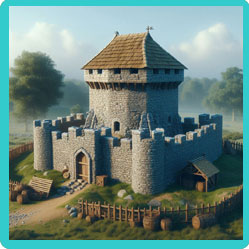
Castles
Castles are some of the most iconic and powerful symbols of the medieval world. From wooden forts to massive stone strongholds, they played a key role in battles, politics, and everyday life. Whether you're looking at the Norman invasion or life in the Middle Ages, castles help bring history to life.
What Is a Castle?
A castle is a large, fortified building — basically part home, part military base. Unlike ordinary houses, castles were built to protect people and territory, especially during times of war or unrest. They often included strong walls, towers, and moats to keep enemies out.
When and Why Were Castles Built?
Castles first appeared in England after the Norman Conquest in 1066, when William the Conqueror needed to control the land and its people quickly. They were built to:
- Defend against attacks
- Show power and control
- Serve as homes for important lords and knights
- Control local areas and roads
Over time, castles became more than just fortresses — they became symbols of wealth and status.
How Were Castles Built?
Building a castle was no small job. It took:
- Planning: Choosing a strong position (on a hill or near a river)
- Materials: Early castles used wood, but later ones were built from stone
- Workers: Labourers, skilled stonemasons, carpenters, and engineers
- Time: Wooden castles could go up in days or weeks; stone ones took years
The design also had to balance defence, comfort, and control.
Revision Notes

The Cornell method is like a supercharged note-taking system that helps you ace your revision!
Print out our blank revision notes pages to help you revise.
How to make effective revision notes with the Cornell method.
Exam Questions & Answers

Download and print off practice our FREE worksheet with exam style questions on Cell Biology.
Types of Castles
Motte and Bailey Castles
These were the first castles built by the Normans. Quick to build using timber, they had:
- A motte: A raised earth mound with a tower on top
- A bailey: An enclosed courtyard below, surrounded by a wooden fence
They were cheap and fast, but easy to burn or rot.
Stone Castles (Medieval Castles)
Later castles were built from stone to be stronger and longer-lasting. They included:
- Keeps: Tall stone towers for defence and living space
- Curtain walls: Thick outer walls around the castle
- Gatehouses, drawbridges, and moats: To protect entrances
- Towers and arrow slits: For better defence in battle
These became the classic medieval castles we recognise today.
Life in a Castle
Castles weren’t just military buildings — they were also homes. Life inside depended on your role:
- Lords and ladies lived in relative luxury, with feasts, music, and servants
- Knights and soldiers trained, patrolled, and guarded the castle
- Servants and workers did cooking, cleaning, repairs, and looked after animals
Castles could be cold, dark, and smoky, but they were safer than living in a village during violent times.
5 Castle Facts
- The Tower of London began as a Norman stone keep
- Arrow slits made it easy to shoot out — but hard to shoot in
- Castles were sometimes attacked with fire, siege towers, or catapults
- Some castles were royal homes; others were owned by powerful nobles
- Over time, castles were replaced by palaces as warfare changed
Links For Learning
Castles of Britain: Castle Learning Center
Quizlet: Motte and Bailey Castles
History Learning Site: Castles
DK Find Out: Castles
DK Medieval Life: Castles
Ducksters: The Middle Ages
Playground Equipment: Castles of the Middle Ages
EHow: Draw a medieval castle floor plan
The Helpful Art Teacher: Parts of a Medieval Castle
Exploring Castles: Life in a Medieval Castle
Castles: People of the Castle
Revision Notes

The Cornell method is like a supercharged note-taking system that helps you ace your revision!
Print out our blank revision notes pages to help you revise.
How to make effective revision notes with the Cornell method.
Why Do I Need to Know About Castles?
In Everyday Life
- Understand how people protected themselves and their homes
- Spot how buildings can show power, wealth, and control
- Learn how daily life was shaped by status and security
- See how ideas from the past still influence buildings today
In History & Related Careers
- Explore how castles link to big themes like war, power, and society
- Understand how architecture reflects political control
- Develop skills in analysing historical evidence and sources
- Prepare for careers in archaeology, heritage, or historical research


